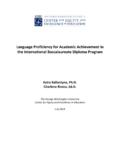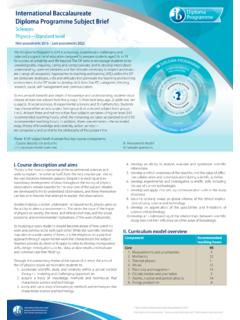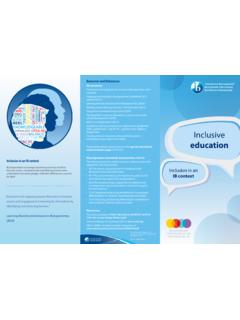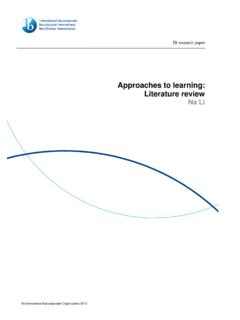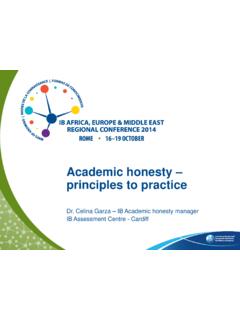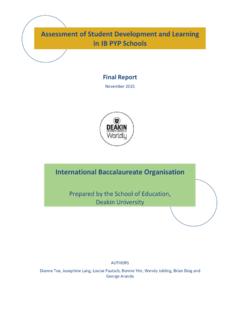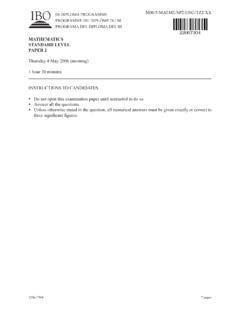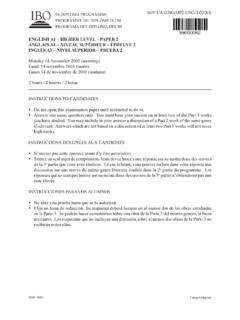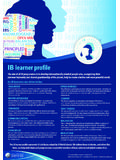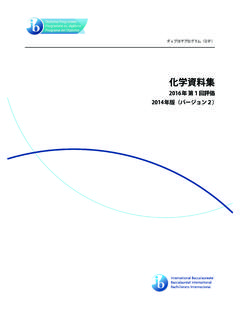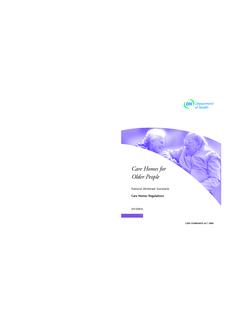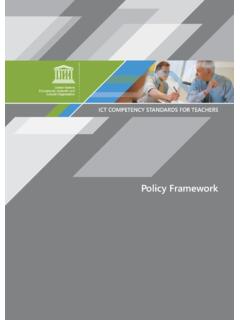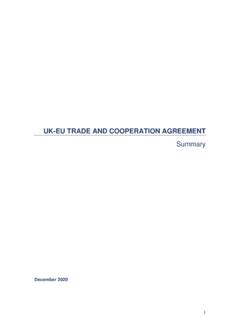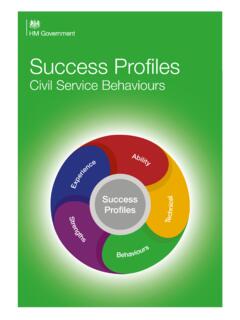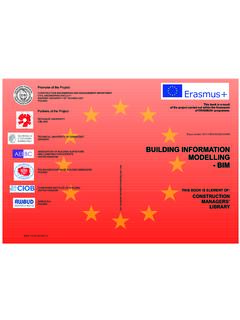Transcription of IB MATHEMATICS COMPARABILITY STUDY
1 IB MATHEMATICS COMPARABILITY STUDY : CURRICULUM & ASSESSMENT COMPARISON Adriana Alc ntara, international Education Consultant REPORT FOR IB GLOBAL RECOGNITION, September 2015 UK NARIC The national Recognition Information Centre, United Kingdom Prepared by: Liz Bergeron, University of Wisconsin-La Crosse The summary is based on full reports by Adriana Alc ntara and UK NARIC. 1 Introduction Purpose and Scope of the IB MATHEMATICS COMPARABILITY STUDY This report summarizes two independently written reports created as a part of the IB MATHEMATICS COMPARABILITY STUDY . The purpose of the IB MATHEMATICS COMPARABILITY STUDY is to review and compare a selection of well-established MATHEMATICS qualifications offered in a range of high-performing education systems around the world whose primary function is to prepare senior secondary students for higher education.
2 1 In this STUDY , IB s four Diploma Program MATHEMATICS courses Mathematical Studies SL, MATHEMATICS SL, MATHEMATICS HL and Further MATHEMATICS HL are compared with five MATHEMATICS qualifications chosen on the basis of their market share, the extent of their university recognition, geographical spread and their performance on PISA tests (where relevant):2 1) Alberta Diploma (Canada): Alberta Math 30-1, Alberta Math 30-2, Alberta 31 2) Advanced Placement (AP) (US and Canada, growing overseas market): AP Calculus AB, AP Calculus BC 3) GCE A Levels (England and overseas market): A Level MATHEMATICS and A Level Further MATHEMATICS 4) Singapore-Cambridge GCE A Levels (SIPCAL) (Singapore): Singapore H1 Math, Singapore H2 Math, Singapore Math H3 5) G ok o (China): G ok o This STUDY is composed of two distinct components: the Curriculum Comparison, which involves a compilation, analysis and comparison of the attributes of these qualifications, and the Assessment Comparison, which involves a comparative analysis of the assessment objectives, assessment methods, and marking guidelines.
3 Dr. Adriana Alc ntara performed the curriculum analysis and the national Recognition Information Centre in the United Kingdom (UK NARIC) conducted the assessment comparison. It is important to note the term curriculum is used when referring to the content of the qualifications analyzed. Often studies of this nature use the term standards . Standards are generally considered the benchmark for judging student progress. Standards outline what students are expected to know at each level. Curriculum is generally understood to be more comprehensive. Curriculum usually refers to the collection of teaching materials used to facilitate student learning so that each student can reach or exceed the standards.
4 Theoretical framework This work extends on two previous alignment projects involving the IB DP. In 2014 Dr. Faas explored the extent the IB DP aligns with national standards in selected regions in Germany and Switzerland3. Additionally, Dr. Conley performed an alignment STUDY between the IB DP and the Knowledge and Skills for University Success (KSUS). Faas research compares the DP written curriculum to selected German and Swiss regional curriculums with regard to content, cognitive demand and philosophical underpinnings. The findings suggest that while there is a high level of content alignment between the DP and Swiss and the DP and German curriculums in the natural sciences (biology and MATHEMATICS ), there is less alignment in the social sciences 1 IB MATHEMATICS COMPARABILITY STUDY Project Plan, 29/01/2015.
5 2 The focus of this STUDY is on the qualifications themselves, not on the national or state systems that sustain them (in the relevant cases). 3 Faas, D, & Friesenhahn, I. (2014a). Curriculum Alignment between the IB DP and national systems: Germany. Bethesda, MD, USA. international baccalaureate Organization; Faas, D, & Friesenhahn, I. (2014b). Curriculum Alignment between the IB DP and national systems: Switzerland. Bethesda, MD, USA. international baccalaureate Organization. 2 and humanities (history and Spanish). The DP also appears to offer greater flexibility than the Swiss and German curriculums, allowing students to pursue their academic interests.
6 In 2009 Conley and Ward4 analyzed the alignment of the IB DP standards and the Knowledge and Skills for University Success (KSUS) and found IB standards to be highly aligned with the KSUS standards. The STUDY also confirmed complete alignment between the IB Diploma s mathematical studies and the KSUS algebra, trigonometry and statistics standards. Methodology There are numerous methodologies for investigating curriculum comparisons5. Researchers often rely on methods like the Webb Model6 or the Achieve Model7 which convene a panel of judges to score intended curriculum using qualitative and quantitative indicators. This can be difficult to apply to the international comparisons required by this STUDY because consistent information is not available for all the courses examined in this research.
7 It is difficult to gather exactly the same categories of data, in the same degree of detail, from a wide range of international educational qualifications, due to language barriers, different rules about the public accessibility and confidentiality of data, or simply different approaches to laying out curricular requirements. Therefore, it is not feasible to establish the uniform scoring categories required by the Webb Model or Achieve Model. To encourage an objective analysis two independent researchers were commissioned to carry out the curriculum and assessment comparisons. Similar to the Webb Model and the Achieve Model, both researchers utilized the intended curriculum in their analyses.
8 The curriculum comparison was performed by Dr. Adriana Alc ntara. Data was gathered mainly from primary sources, consisting of the most recent guidance documents and course specifications or guides provided by the administering authorities of each qualification (available on their official websites). Secondary sources were also used to enrich the data, namely existing international studies that have compared various MATHEMATICS qualifications. One particularly useful source for this report is Ofqual s 2012 international Comparisons in Senior Secondary Assessment (hereafter referred to as ICOSSA), which provides a methodological model in some ways, and contains a large amount of detailed data on several of the qualifications included in this STUDY .
9 With regard to concerns over objectivity, the curriculum research highlights similarities and differences between other qualifications and IB qualifications in its analysis and conclusions, but IB qualifications were not used as a benchmark against which to compare the others. In order to establish an external framework for determining certain equivalencies between the qualifications, the textbooks and course outlines used by top global universities in science and engineering were referred to for defining objective categories of MATHEMATICS content. The assessment comparison was carried out by UK NARIC. Again, because each qualification being compared had different details available it was difficult to quantitatively score the qualifications.
10 Therefore, a qualitative comparison approach was utilized. To arrive at a point at which reliable comparisons could be drawn between the international awards; it was important to thoroughly explore each qualification and its MATHEMATICS 4 Conley, D., Ward, T. (2009). international baccalaureate Standards Development and Alignment Project. Educational Policy Improvement Center, Eugene, Oregon. 5 Bloom, , Madaus, , & Hastings, (1981). Evaluation to Improve Learning, New York: McGraw-Hill.; Webb, (1999). Alignment of Science and MATHEMATICS Standards and Assessments in Four States, Washington: Council of Chief State School Officers.
